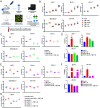17β-estradiol promotes extracellular vesicle release and selective miRNA loading in ERα-positive breast cancer
- PMID: 37252969
- PMCID: PMC10266002
- DOI: 10.1073/pnas.2122053120
17β-estradiol promotes extracellular vesicle release and selective miRNA loading in ERα-positive breast cancer
Abstract
The causes and consequences of abnormal biogenesis of extracellular vesicles (EVs) are not yet well understood in malignancies, including in breast cancers (BCs). Given the hormonal signaling dependence of estrogen receptor-positive (ER+) BC, we hypothesized that 17β-estradiol (estrogen) might influence EV production and microRNA (miRNA) loading. We report that physiological doses of 17β-estradiol promote EV secretion specifically from ER+ BC cells via inhibition of miR-149-5p, hindering its regulatory activity on SP1, a transcription factor that regulates the EV biogenesis factor nSMase2. Additionally, miR-149-5p downregulation promotes hnRNPA1 expression, responsible for the loading of let-7's miRNAs into EVs. In multiple patient cohorts, we observed increased levels of let-7a-5p and let-7d-5p in EVs derived from the blood of premenopausal ER+ BC patients, and elevated EV levels in patients with high BMI, both conditions associated with higher levels of 17β-estradiol. In brief, we identified a unique estrogen-driven mechanism by which ER+ BC cells eliminate tumor suppressor miRNAs in EVs, with effects on modulating tumor-associated macrophages in the microenvironment.
Keywords: breast cancer; estrogen receptor; exosomes; extracellular vesicles; microRNAs.
Conflict of interest statement
G.A.C. is the scientific founder of Ithax Pharmaceuticals.
Figures






References
-
- Mathieu M., Martin-Jaular L., Lavieu G., Thery C., Specificities of secretion and uptake of exosomes and other extracellular vesicles for cell-to-cell communication. Nat. Cell Biol. 21, 9–17 (2019). - PubMed
-
- Valadi H., et al. , Exosome-mediated transfer of mRNAs and microRNAs is a novel mechanism of genetic exchange between cells. Nat. Cell Biol. 9, 654–659 (2007). - PubMed
Publication types
MeSH terms
Substances
Grants and funding
LinkOut - more resources
Full Text Sources
Medical
Molecular Biology Databases

